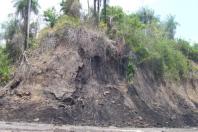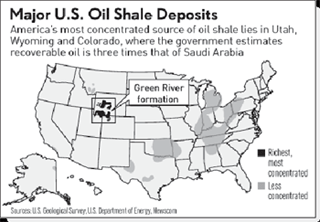US (oil shale)
The plot:
Whether in Estonia, Israel or elsewhere, the prize sought by oil shale kerogen extraction methods is the Green River Formation in the United States. Over half the possible crude oil reserves on the planet are contained in Colorado, Wyoming and Utah. Current experimentation and exploration is carried out with the goal of eliminating opposition to development, environmental opposition mainly at this time is rooted in both water and energy/C02 output, both projected to have catastrophic footprints.
The details:
US oil shale deposits, for the purposes of this website are limited in listing to those reserves that would not require hydraulic-fracturing (“fracking”) but forms of in-situ or mining operations that extract kerogen from shale-rock through a “retorting” process. In short form, this means to list deposits where the substance in the ground is not oil trapped within layers of shale and similar formations, but pre-oil kerogen that is a part of the shale basin itself. To “bleed” out the kerogen from the shale-- whether done in-situ or through a mining process-- involves a procedure that has far more in common with the extraction models developed for Canadian tar sands and Estonian oil shale than the “fracking” method of releasing trapped, liquified oil.
For these forms of oil shale, the main deposits are the Green River Formation, the vast oil shale deposit that covers areas of Wyoming, Colorado and Utah. Though small in acreage, the density of barrels per acre outstrip the largest fields in the world, such as the Canadian Athabasca Region, by many times over. The estimated number of barrels of Kerogen/oil shale in place has been put as high as 3 trillion barrels, and given the proximity to the surface perhaps overly optimistic engineers have placed nearly half that number as “recoverable.” 800 bn bbl is the minimum agreed upon by most sources.
Today Royal Dutch Shell (UK), Eesti Energia (Estonia) and Genie Energy (US) are all seeking experimentation and research into oil shale kerogen extraction primarily in Colorado. In the state of Utah, Red Leaf Resources-- a Salt Lake City, Utah situated company-- has leases and is moving ahead with water use permits towards production of synthetic oil from shale production, in concert with French energy giant TOTAL.
At the time of the 1970's energy crisis there was a short lived boom in oil shale development plants, refineries and more in differing places in the GRF. By 1983 they had all closed down. In recent years Royal Dutch Shell has continued low level experimentation to establish an extraction process that would be technologically and financially viable. Today's near permanent high prices of oil on the world market have combined with Shell to produce a form of possible “in-situ” development that would see the deposit in the ground heated via long coils (and the energy used to run them 24 hours a day) over a period of years. Eventually, so the theoretical plan would be, the breaking down of shale and subsequent “bleeding” of kerogen out of the rock would provide extraction of the world's largest-- and likely dirtiest-- hydrocarbon deposit.
Genie Energy is the parent company of the oil shale project in the Shfela basin (carried out under the name Israel Energy Initiatives) outside of Jerusalem, and hopes the technology the wish to implement there can also be applied after the fact in the GRF of Colorado and elsewhere. Harold Vinegar, today's lead researcher in IEI's project, also spent decades as the head of the same research in the United States working for RDS.
The joint Red Leaf/TOTAL project would effectively commercialize oil shale; oil shale and tar sands are seen by the US Federal government as the same things; given the interconnected nature of deposits, so too should climate concerned individuals and groups.



